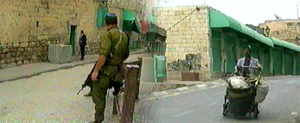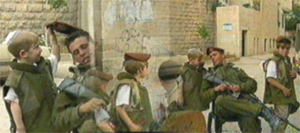

Biography
Horit Herman-Peled, media artist, resides in Tel Aviv.
In February 1999 she was invited by the Graduate Consortium in Women's Studies at Radcliffe College to give the Genevieve McMillan-Reba Stuart Lecture on Women in the Developing world. Her multimedia presentation was titled "Blessed Be He Who Did Not Make Me A Woman."
In the summer of 1998 she presented "The Disappearance of the Art Object" at the Isea98 Revolution Symposium in Liverpool, England. At the Isea98 Terror in Manchester, England, she chaired the session "Terror: Stripping and Constructing Identities."
In March-April 1999 she is showing "imagination/simulation: the soldier, the woman," multimedia art in-situ with painter Chava Raucher, at the Painters' and Sculptors' Association Gallery in Tel Aviv.
Her ongoing project, "Gaza Checkpoint - Stripping Identities/Digital Terror," can be viewed at: http://www.mofet.macam98.ac.il/~horit_a/horit.htm
In 1989 she presented "Homage to Franz Marc," at Artware, CEBIT, Hanover, Germany.
She was a member of the International Organizing Committee, Isea98.
She is Artistic Director of Pollack/Kalisher Art College and teaches media art and culture at the Art Department of Talpiyot College in Tel Aviv and at the Art Institute, Oranim College, in Kiryat Tivon.
 Conceptual
Description
Conceptual
Description
Interventions–Hebron 1998
This CD-ROM work is a visual web constructed of interactive points signifying
intersections of surveillance units.
Each surveillance unit forms a checkpoint composed of several soldiers, weapons, electronic equipment and barricades. The checkpoints are planted all over the urban geography of the ancient town Halil /Hebron, drawing an iron screen over its 100,000 Arab inhabitants.
These checkpoints are transparent in the eyes of the few hundred Jewish settlers, roaming around Hebron, yet they are not blind to the Palestinians who are forbidden to drive and can walk only under the gaze of the Israeli soldiers and settlers.
I believe that a meaningful art work on the plane of the digital revolution is a work that points towards the possible fulfillment of the emancipatory potential inherent in this revolution. It is a work that utilizes the advances of technology in order to criticize and subvert the socio-economic and political contexts within which this technology is created, diffused and controlled. Since the means of digital artistic production are predetermined and controlled by profit-making corporations, to be a responsible citizen of the global village, the artist must seek to express the voice of those who are terrorized into silence by the digital revolution.
